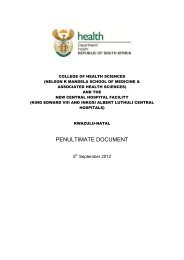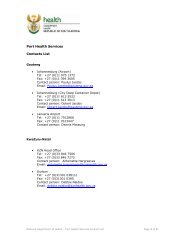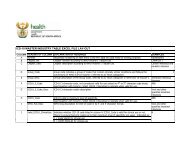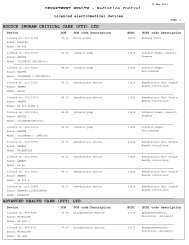• The name of the health care facility, ward, date of containerization <strong>and</strong> the service provider alsoappear on each HCRW container.2.12 PACKAGING OF WASTE2.12.1 Packaging of infectious waste pathological waste (excluding sharps)a) The environmental health HCRW audit of a facility should also include the inspection of packaging ofinfectious waste. An EHP should moni<strong>to</strong>r that:• The packaging for infectious waste is made from an impermeable <strong>and</strong> leak proof material;• Packaging for infectious waste is filled up <strong>to</strong> three quarters capacity of the container <strong>and</strong> is securelyclosed;• Plastic bags are closed by means of non PVC plastics ties, non PVC plastic sealing tags of the selflocking type or heat sealers that are purposely made for health care risk waste. The use of staplerson plastic bags is not be allowed;• A pathological waste container lids have an airtight seal <strong>to</strong> prevent the emission of any odours; <strong>and</strong>• The package is properly labeled as per table 1 above.2.12.2 Packaging for sharpsSharps refer <strong>to</strong> waste having acute rigid corners or edges capable of causing cuts <strong>and</strong> wounds <strong>and</strong>includes but not limited <strong>to</strong> items such as needles, syringes, blades or clinical glass, hypodermic needles,scalpels.a) An EHP should moni<strong>to</strong>r that:• All sharps containers utilized are manufactured according <strong>to</strong> SANS 452 <strong>and</strong> are made of rigid,puncture proof, tamper proof, <strong>and</strong> leak proof material;• All sharps containers have a tight fitting lid that cannot be opened easily; are tightly closed with a nonreversible sealing designed lid when full so as <strong>to</strong> prevent accidental spillage <strong>and</strong> forceful opening;<strong>and</strong> are available in each department or unit <strong>and</strong> be appropriate for the type of work e.g. large sharpscontainer where trocars are used.2.12.3 Packaging for chemical wastea) An EHP should moni<strong>to</strong>r that:• Chemical waste is sorted as per the specifications of the (Annexure D- SANS 10248-1:2008extract);• Hazardous chemical waste of different classes is not mixed with other waste;• Alternatively, chemical waste may be placed in original containers that contained same type ofchemical, provided that the original label is removed or clearly defaced;• All chemical waste have a material safety data sheet; <strong>and</strong>• Have an international hazard label <strong>and</strong> the colour coding as per table 1 above.2.12.4 Packaging for other waste in a health facilitya) An EHP should also moni<strong>to</strong>r <strong>to</strong> ensure that:• Waste aerosol dispensers are s<strong>to</strong>red in black plastic bags <strong>and</strong> marked “Waste aerosol dispensers”, <strong>to</strong>distinguish from general waste;• Empty gas cylinders are not incinerated but are shall <strong>to</strong> the supplier for reuse, where appropriate;• Chlorinated <strong>and</strong> non chlorinated solvents are segregated <strong>and</strong> s<strong>to</strong>red in separated waste containers;• Waste flammable liquid can be s<strong>to</strong>red in a metal or high density plastic container or drum that can besealed with a screw cap lid;• Alternatively, flammable liquids may be s<strong>to</strong>red in original that contained same flammable liquid,provided that the original label is removed or clearly defaced; <strong>and</strong> the international hazard label <strong>and</strong>the colour coding is done be as per table 1 above;• Waste oxidizing substances <strong>and</strong> organic peroxides are segregated as per (Annexure D- SANS10248-1:2008–extract).DOH. <strong>Norms</strong> <strong>and</strong> st<strong>and</strong>ards for environmental health in South Africa Feb 2013 128
• Waste oxidizing substances <strong>and</strong> organic peroxides are s<strong>to</strong>red in plastic lined metal drums, or highdensity plastics drums, fitted with tamperproof sealable lids; <strong>and</strong> the international hazard label <strong>and</strong>the colour coding is per table 1;• Waste <strong>to</strong>xic substances is segregated <strong>and</strong> each type of waste is s<strong>to</strong>red separately;• Waste <strong>to</strong>xic substances are s<strong>to</strong>red in a metal or high density plastic container or drum, which can besealed with a screw cap lid;• Empty containers in which extremely <strong>to</strong>xic chemicals are supplied are not be s<strong>to</strong>red for future use aswaste s<strong>to</strong>rage containers; <strong>and</strong>• Liquid pharmaceutical waste containers are made of metal , or high density plastics , fitted withtamperproof lid or screw cap lid.• Solid pharmaceutical waste is s<strong>to</strong>red in double layer plastic bags, secured by means of non PVCplastics ties, steel wire, non PVC plastic sealing tags of the self locking type or heat sealers that arepurposely made for health care risk waste; <strong>and</strong> the label is per the international hazard colour codingas per table 1;• Cy<strong>to</strong><strong>to</strong>xic <strong>and</strong> geno<strong>to</strong><strong>to</strong>xic pharmaceuticals contaminated are segregated <strong>and</strong> s<strong>to</strong>red in sharpscontainer; <strong>and</strong>• Cy<strong>to</strong><strong>to</strong>xic <strong>and</strong> geno<strong>to</strong><strong>to</strong>xic pharmaceuticals waste <strong>and</strong> contaminated materials is s<strong>to</strong>red in containersmade of metal, or high density plastics, fitted with tamperproof lid or screw cap lid.2.13 LOADING, STORAGE AND TRANSPORTATION AND DISPOSAL OF HCRWAn EHP should also moni<strong>to</strong>r that the loading, s<strong>to</strong>rage <strong>and</strong> transportation <strong>and</strong> disposal of HCRW, <strong>to</strong>ensure that the following requirements are met:2.13.1 Internal loading <strong>and</strong> transportation of health care risk waste in a facilitya) <strong>Health</strong> care risk waste must be transported as follows within a facility:• On wheeled trolleys, containers or carts, with sufficient s<strong>to</strong>rage space <strong>and</strong> designed <strong>to</strong> avoidspillages;• Waste at all major genera<strong>to</strong>rs must be collected <strong>and</strong> removed from the wards <strong>and</strong> departments on adaily basis <strong>and</strong> be s<strong>to</strong>red in locked central s<strong>to</strong>rage area;• The manual lifting of <strong>and</strong> carrying of waste should be avoided <strong>and</strong> minimized;• Access <strong>to</strong> transportation vehicles must be easy, safe <strong>and</strong> unobstructed;• Containers must tightly close <strong>and</strong> secured when loaded;• No waste container must be left unattended during loading <strong>and</strong> transportation;• The container, or trolley or cart wheels must always be locked when not in motion;• The equipment used for transportation must be: Easy <strong>to</strong> load <strong>and</strong> unload; Free from sharp edges that could damage containers during loading or unloading; Easy <strong>to</strong> clean <strong>and</strong> disinfect;• The mode of transport <strong>to</strong> treatment <strong>and</strong> final disposal site must be labeled with appropriate pic<strong>to</strong>gramas prescribed in relevant SANS;• The following information must be recorded for offsite collection of HCRW; Signatures of both the person in charge of the central s<strong>to</strong>rage facility <strong>and</strong> the waste managemen<strong>to</strong>fficer or waste management team member responsible for effective management of waste; Time <strong>and</strong> date of collection; The volume of waste collected for different categories of waste.2.13.2 S<strong>to</strong>rage of health care risk wastea) In terms of the SANS Code 10248, all health care facilities or health establishments must have atemporary waste s<strong>to</strong>rage area, the location thereof must be such that there is minimal risk ofcontamination <strong>to</strong> main operations of that area, medicines, foodstuffs, textiles, employees, patients<strong>and</strong> visi<strong>to</strong>rs.b) Minor genera<strong>to</strong>rs, such as clinics can use the sluice room as a temporary waste s<strong>to</strong>rage area.c) All HCRW s<strong>to</strong>red at minor genera<strong>to</strong>rs must be removed <strong>to</strong> the final s<strong>to</strong>rage area regularly <strong>to</strong> preventthe occurrence of any nuisances.DOH. <strong>Norms</strong> <strong>and</strong> st<strong>and</strong>ards for environmental health in South Africa Feb 2013 129
- Page 1 and 2:
No. 36849 GOVERNMENT GAZETTE, 20 SE
- Page 3 and 4:
AcknowledgementsDrafting Team (Nati
- Page 5 and 6:
Preamble by Director-GeneralThe Nat
- Page 7 and 8:
POLICY AND LEGISLATIVE FRAMEWORKThe
- Page 9 and 10:
1. Introduction1.1 Policy contextOn
- Page 11 and 12:
5. Monitoring and enforcing complia
- Page 13 and 14:
BACKGROUNDHealth surveillance of pr
- Page 15 and 16:
h) Adequate and potable water avail
- Page 17 and 18:
a) Entrance and exit control must b
- Page 19 and 20:
• Storage of unsafe, toxic, dange
- Page 21 and 22:
(i) For children between 0-24 month
- Page 23 and 24:
• The health certificate holder,
- Page 25 and 26:
a) Separate storage facilities must
- Page 27 and 28:
2.4 Inspections should include an a
- Page 29 and 30:
g) Adequate facilities must be prov
- Page 31 and 32:
d) Corridors must be at least 1.8m
- Page 33 and 34:
1. NORMS1.1 Schools to be operated
- Page 35 and 36:
• A cardiopulmonary mouthpiece pr
- Page 37 and 38:
a) All circumcisions must be conduc
- Page 39 and 40:
) Toilets, wash hand basins and bat
- Page 41 and 42:
• Liquid soap;• First aid instr
- Page 43 and 44:
h) A daily record must be kept on t
- Page 45 and 46:
t) A separate room or area with sep
- Page 47 and 48:
h) An adequate number of purpose-ma
- Page 49 and 50:
c) Health care facilities should ha
- Page 51 and 52:
a) All facilities used in connectio
- Page 53 and 54:
5. General hygiene requirementsa) T
- Page 55 and 56:
1.1 The premises operated under a v
- Page 57 and 58:
5. Environmental health should cond
- Page 59 and 60:
d) The use of non-waterborne sanita
- Page 61 and 62:
so many kgs of manure is produced p
- Page 63 and 64:
a) On any residential premises, onl
- Page 65 and 66:
n) A rodent-proof storeroom must be
- Page 67 and 68:
d) Pets must be vaccinated against
- Page 69 and 70:
1.3 The premises in compliance with
- Page 71 and 72:
2.1 Environmental health inspection
- Page 73 and 74:
2.1 Environmental health inspection
- Page 75 and 76:
1) Responsibility of management1.1.
- Page 77 and 78: that all possible health impacts of
- Page 79 and 80: BACKGROUNDThe Scope of Profession o
- Page 81 and 82: a) An Integrated Disease Surveillan
- Page 83 and 84: a) All food onboard must be stored
- Page 85 and 86: 3. Waste managementa) The managemen
- Page 87 and 88: c) Documents outlining prevention,
- Page 89 and 90: Chapter 3HEALTH RELATED WATER QUALI
- Page 91 and 92: d) The catchment (rivers, treatment
- Page 93 and 94: f) Ensuring monitoring of effective
- Page 95 and 96: SECTION 4:WATER QUALITY MONITORING
- Page 97 and 98: water world etc)1. In the event of
- Page 99 and 100: Step 2: if water is obtained from t
- Page 101 and 102: • Of the time frame, if any, with
- Page 103 and 104: 3. Household grey-water (generated
- Page 105 and 106: SECTION 14:MONITORING OF DRINKING W
- Page 107 and 108: contamination (e.g. from birds and
- Page 109 and 110: SECTION 21: COMPLIANCE ENFORCEMENT6
- Page 111 and 112: DEFINITION OF APPLICABLE TERMSThe f
- Page 113 and 114: BACKGROUNDWaste management is the c
- Page 115 and 116: • Provides municipal health servi
- Page 117 and 118: a) The premises used for recycling
- Page 119 and 120: SECTION 4: COLLECTION OF GENERAL WA
- Page 121 and 122: SECTION 7: CLASSIFICATION, PACKAGIN
- Page 123 and 124: • The spillage area shall be mark
- Page 125 and 126: • Elbow length heavy duty gloves,
- Page 127: anatomical waste anatomical • Hav
- Page 131 and 132: Sharps container 90 days Cool room
- Page 133 and 134: Relationships between transboundary
- Page 135 and 136: Chapter 5HAZARDOUS SUBSTANCES AND C
- Page 137 and 138: 3. The premises used in connection
- Page 139 and 140: d) In addition, all hazardous subst
- Page 141 and 142: 4. Guidelines for Drinking Water Qu
- Page 143 and 144: for conducting monitoring.7. Analyz
- Page 145 and 146: Bacterial infectionsCholeraCampylob
- Page 147: paralytic aspeticmeningitis. The re


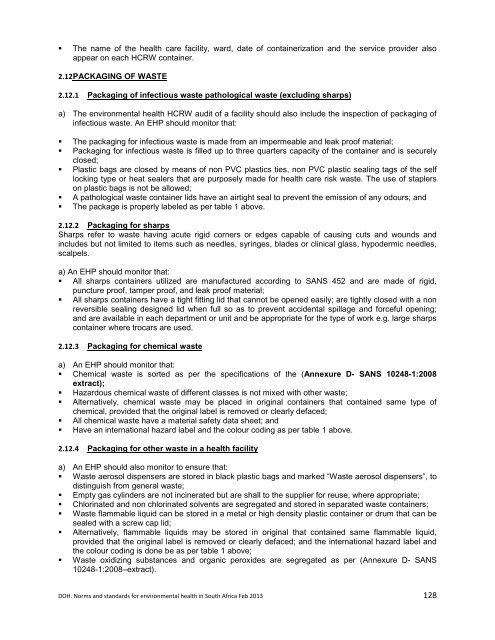


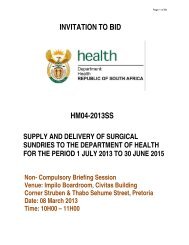
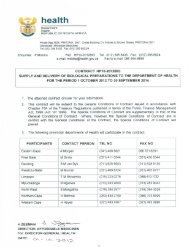
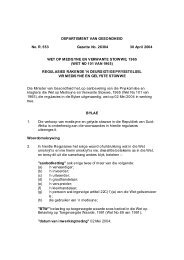
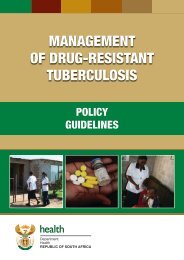
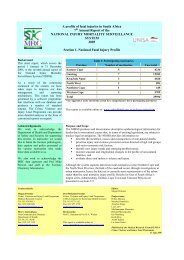
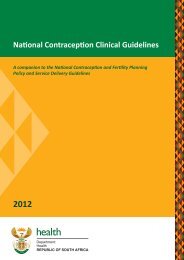
![A monograph of the management of postpartum haemorrhage [2011]](https://img.yumpu.com/15578784/1/184x260/a-monograph-of-the-management-of-postpartum-haemorrhage-2011.jpg?quality=85)
